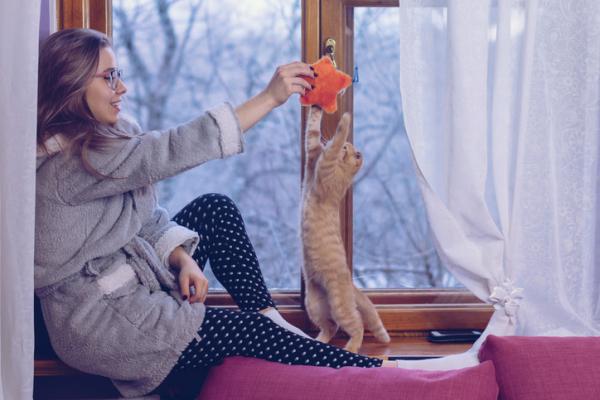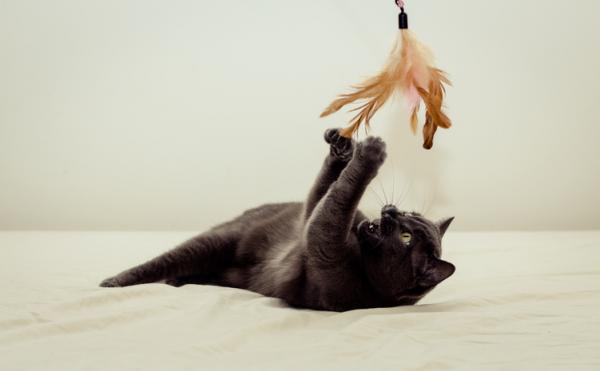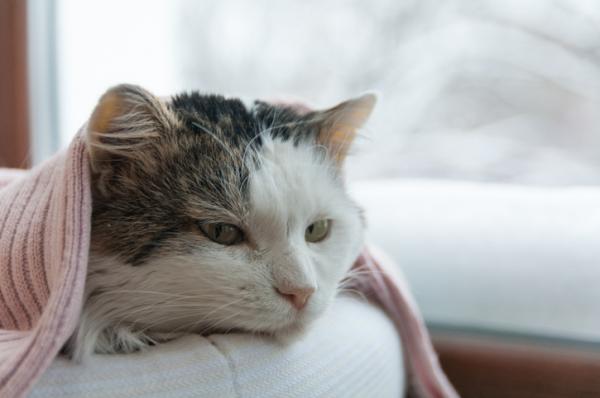How to play with a cat?

The game is a fundamental activity for the cat and a healthy physical constitution as well as a positive emotional state will depend on it. If you observe your cat cleaning up excessively, eating compulsively or sleeping more than 18 hours a day, you can consider that there is a problem related to stress, which can help channel a positive routine of games and interaction.
In addition, it is common for domestic cats to have limited hunting behavior, innate in its species, which usually causes frustration or redirection of the behavior, which shows as a direct attack on the hands or ankles of the owner.
In this article we will show you everything you need to know about how to play with a cat, recommending you toys, explaining in detail the feline behavior related to the game and hunting and also giving you ideas and tips to improve their quality of life. Take note!
Why is playing with a cat so important?
The lifestyle significantly influences behavior and well-being of the feline. While it is true that cats sleep many hours a day, between 12 and 18, it is also important to note that when they are awake, their activity level is very intense, something that is often reduced when we face domestic cats who live in a home without access to the outside.
In these cases, felines can not carry out the hunting behavior, which in the wild would take up to six hours of daily physical activity to cover their nutritional needs. That translates into bored cats, overweight cats or cats that can not hunt small insects or toys.
In addition, this problem is aggravated when the owner is not able to correctly interpret the feline language and considers that the cat may be asking for food, when in fact it is looking for social interaction and play. When playing with cats, we improve your quality of life, well-being, relationship with the owner and prevent various problems already mentioned, such as excessive weight and stress. For that reason, it is so important to play with a cat.

What do cats play with?
Cats are curious animals that they need to experience new experiences to feel stimulated and it is important to emphasize that they do not always use predesigned toys as an exclusive form of entertainment. A cat can play with plants, boxes, catnip or catnip and even with the appearance of any new object in the home that will provide curiosity and challenge your senses.
However, when it comes to wanting to play with a cat, it may be advisable to use toys to avoid possible scratches and bites, since the game behavior is very related to hunting. So, what toys should we choose to know how to play with a cat and motivate it in a positive and accurate way?
Hunting toys
Hunting toys are usually the most recommended and we can highlight the Rod or toy cane, whether it has feathers or stuffed animals at the end. It is usually the most appreciated toy by cats, although each has its own preferences. We also find inside this category the stuffed mice or the interactive toys that move alone, like the butterfly toy for cats, many of them also emit noise.
Intelligence toys
We can also use intelligence toys, such as circuits with ball for cats, kong and other similar toys that act as food vending machines. In general, these types of toys combine physical and mental stimulation, but do not include the owner as a participant in the game.

How to make a cat play? – 5 fun games
The game behavior is fundamental and necessary for any cat, regardless of age, so it is advisable to dedicate to our best friend quality time at your side that promotes natural game behavior, especially if it is combined with hunting behavior. As owners, we must strive to know the cat preferences as well as perform activities that encourage feline nature.
Next we propose 5 games for home cats:
- Motivate with the fishing rod: it is usually the most attractive game for a cat, since the rapid movement of the fishing rod catches the attention of felines, who are much more sensitive to movement. If you do not have this toy, you can use any other you have on hand, moving it constantly.
- Play hide and seek with the cat: Do you think that dogs are the only ones that can play hide and seek with humans? Hide behind a door and call your cat to come and look for you. Once I find you, I gratefully and effusively and reward you, even with a little piece of food. You can always use the same words to associate them with this activity. For example, “Garfield, where am I? ‘
- Proception exercises: to do this activity you will not need much and, in return, you will achieve that your cat stimulates its balance, touch and also the sense of sight. They are especially popular in dogs, but they can also be excellent in cats. In addition, they help the cat to gain self-confidence. You will only need to place different textures and objects in a room, for example, bubble wrap, a square meter of fake grass or a staircase on the floor. Then you should spread prizes for the cat or rub them with catnip. The cat will experiment with new textures and forms, while discovering.
- Olfactory exploration: Try to hide in a cardboard box of more or less closed toilet paper different herbs with odors, always paying attention to avoid the toxic plants for cats. Some examples can be catnip, valerian or aloe vera. You will have a great time discovering new things.
- Tunnels and hidden prizes: In any specific trade for pets (and even for children) you can find tunnels that your cat will love. Hide inside the tunnel a prize or a plant that can attract you to stimulate your curiosity. If you do not know what to use, discover 10 odors that attract cats.
Why does not my cat play alone?
Many people confuse the enrichment of the home with leaving all the toys available to the cat. This is a mistake. You should know that cats show a lot of interest for new objects, substances and smells, therefore, after a single session of games and without the stimulation that you can provide them, a static object does not cause them any curiosity, so they stop playing alone, even when we talk about interactive toys or those that move alone.
It can be very interesting to have a box with toys of our cat and withdraw only one or two daily, with the aim of showing interest in them. If the goal is to play with us, we will spend time to surprise you with those toys and socialize, but if on the contrary the goal is to have fun in our absence, we can rub toys with catnip, to awaken your senses.

Adapting the game to each stage
The game should always be adapted to each stage of the cat, so, we will show you some curiosities that you should know when making your best friend play:
How to play with a small cat?
Kittens are especially playful and easy to motivate and, unless they have had a very traumatic experience, they usually enjoy enormously the game with their humans, conforming to practically any new object within their reach. It is very positive to stimulate them in this stage, although never in an excessive way, since this will favor a more positive behavior and a better well-being, besides predisposing the animal to be playful in all the stages of its life.
How to play with an adult cat?
Not all cats play in adulthood and it may happen that, if they have not learned hunting or game behavior in their socialization stage, they do not know how to play correctly. Some have not even played in their entire lives, since they were separated quickly from their mother and siblings, in addition to the fact that the humans with whom they lived did not motivate them. Therefore, if you have adopted an adult cat and you are not able to make him play, you may find yourself facing this type of case.
How to play with an adult cat that does not know? This is undoubtedly a very complicated case and it takes time, dedication and the use of all possible tools. Combining catnip, toys and movement, we can get our cat to show interest in the game, although in serious cases, such as sensory deprivation syndrome, it can happen that the cat never gets to play.
How to play with older cats?
Have you ever wondered how old are the cats playing? Most owners do not know that many cats play until their old age, although obviously not as active as a puppy cat or adult. In these cases we must adapt the game according to the limitations of the cat itself, but trying to motivate him to keep exercising and stimulating his mind.
How long do you have to play with a cat?
A study published by Universities Federation for Animal Welfare in 165 shelter cats [1] shows a significant improvement in wellness and stress reduction in those individuals who were in an enriched environment, with a management based on positive reinforcement and where consistency prevailed, the opportunity to relate and favoring the natural game behaviors in the feline in a 69-76% of cases.
So, how much time should you play with a cat a day? It is important to note that the needs vary according to each individual and, although it is a fact that the game can improve the levels of stress and anxiety in the feline, a study in the book Animal Behavior highlights the negative effects of excessive stimulation, which would significantly increase stressful situations and that would not always be a welfare indicator in the case of cats that have been deprived of stimulation for a long time.
Therefore, the game should always be favored progressively and adapted to the individual and their specific needs for play, fun and stress reduction. But on average, you could put the daily play time on 30 minutes approximately.

How to know if my cat is playing or fighting?
Especially when we are faced with a problem of aggressiveness in the cat, it can be difficult to differentiate the proper behaviors of the game and those that are effectively part of an aggression towards us. As we have explained previously, aggression can be a consequence of the lack of game, which causes the animal to redirect hunting behavior towards us, although it may also be due to the accumulated energy that it has not been able to channel properly.
But if our cat shows up aggressive beyond the moments of play, we could suspect that the behavior is due to another reason, for example to a lack of socialization, to a trauma or bad experience, due to the feline’s own genetics and even for an organic cause, that is, due to pain or due to a hormonal problem among others.
In case of any of these problems, the most advisable is perform a veterinary exam that discards any pathology and, in the face of serious behavior, consider going to an ethologist or feline educator.
If you want to read more articles similar to How to play with a cat?, we recommend you to enter our section of Games and Fun.


